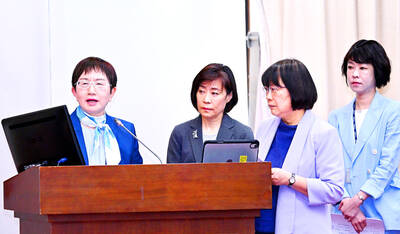Oil on Friday ended its worst week since October last year on a gain, a day after inflation concerns and worries over the trajectory of near-term demand triggered the largest daily loss in several months.
Wall Street banks said the sell-off was transitory.
Futures in New York ended the week 6.4 percent lower, with Friday’s rise doing little to reverse the previous session’s swift price plunge.
West Texas Intermediate (WTI) for April delivery rose US$1.42 to US$61.42 a barrel on Friday, but was down 6.4 percent for the week.
Brent crude oil for May delivery on Friday rose US$1.25 to US$64.53 a barrel, down 6.8 percent weekly.
A combination of factors conspired to bring a more than 30 percent rally this year to a screeching halt: US Treasury yields that pushed the US dollar higher, signs of weaker consumption in Asia in the short-term and the unwinding of long positions by commodity trading advisers.
Technical indicators had shown a market correction was overdue.
Still, investment banks from Goldman Sachs Group Inc to Morgan Stanley & Co said demand is set to recover and supplies would tighten, with the rout offering a buying opportunity for a market that might have gotten too long for its own good.
“What happened yesterday is not indicative of overly soft physical markets,” RBC Capital Markets analyst Michael Tran said. “The market was getting pretty stretched, so given the general headlines of China slowing to some degree, COVID returning in Europe and demand maybe not being as robust as people had thought, these are all just convenient opportunities for the market to rebase, retrench and reload heading into the summer.”
In the days leading up to Thursday’s price rout, money managers cut their bullish positioning in oil, with hedge fund’s combined wagers on rising Brent and WTI prices slumping to a five-week low in the week ending on Tuesday, weekly ICE Futures Europe and CFTC data showed.
However, even after the abrupt setback, futures are still up more than 20 percent so far this year on prospects for a recovery this year from the COVID-19 pandemic and OPEC+’s output discipline thus far.
The sell-off would prove to be “transient” and this week’s decline presents a buying opportunity, Goldman analyst Damien Courvalin said in a note.
There would still be a swift rebalancing of the market, with vaccinations driving an increase in mobility, he said.
Undersupply is likely to continue through this year should demand accelerate and OPEC+ continue to show output restraint, Morgan Stanley said in a report.
In that case, the market should remain in deficit, allowing inventories for countries in OPEC to normalize during the third quarter of this year, analysts Martijn Rats and Amy Sergeant wrote.
Meanwhile, Saudi Arabia said a drone attack at a Saudi Arabian Oil Co refinery in Riyadh had no effect on oil supplies, according to the state-run Saudi Press Agency, which said Yemen’s Iran-backed Houthi rebels were behind the attack.
The S&P 500 Energy Index was little changed on Friday after slumping 4.7 percent on Thursday for its biggest decline in more than three months.
There are signs of weakness in physical market demand, particularly in Asia. At the same time, Europe’s vaccine rollout remains sluggish — another headwind for the recovery in consumption.
The oil market’s structure also weakened markedly. Key gauges of supply for WTI and Brent crude veered nearer to a bearish contango structure, signaling oversupply.
Still, data from the US suggest that the latest bout of fiscal stimulus might help to spur travel there, while a dozen states are expanding access to COVID-19 vaccinations earlier than planned.
“Don’t mistake a correction for a derailment,” JPMorgan Chase & Co analyst Natasha Kaneva wrote in a note to clients. “The price move was likely accentuated by a washout of investor length, which has been steadily rising since late last year.”
Additional reporting by AP, with staff writer

‘SWASTICAR’: Tesla CEO Elon Musk’s close association with Donald Trump has prompted opponents to brand him a ‘Nazi’ and resulted in a dramatic drop in sales Demonstrators descended on Tesla Inc dealerships across the US, and in Europe and Canada on Saturday to protest company chief Elon Musk, who has amassed extraordinary power as a top adviser to US President Donald Trump. Waving signs with messages such as “Musk is stealing our money” and “Reclaim our country,” the protests largely took place peacefully following fiery episodes of vandalism on Tesla vehicles, dealerships and other facilities in recent weeks that US officials have denounced as terrorism. Hundreds rallied on Saturday outside the Tesla dealership in Manhattan. Some blasted Musk, the world’s richest man, while others demanded the shuttering of his

ADVERSARIES: The new list includes 11 entities in China and one in Taiwan, which is a local branch of Chinese cloud computing firm Inspur Group The US added dozens of entities to a trade blacklist on Tuesday, the US Department of Commerce said, in part to disrupt Beijing’s artificial intelligence (AI) and advanced computing capabilities. The action affects 80 entities from countries including China, the United Arab Emirates and Iran, with the commerce department citing their “activities contrary to US national security and foreign policy.” Those added to the “entity list” are restricted from obtaining US items and technologies without government authorization. “We will not allow adversaries to exploit American technology to bolster their own militaries and threaten American lives,” US Secretary of Commerce Howard Lutnick said. The entities

Minister of Finance Chuang Tsui-yun (莊翠雲) yesterday told lawmakers that she “would not speculate,” but a “response plan” has been prepared in case Taiwan is targeted by US President Donald Trump’s reciprocal tariffs, which are to be announced on Wednesday next week. The Trump administration, including US Secretary of the Treasury Scott Bessent, has said that much of the proposed reciprocal tariffs would focus on the 15 countries that have the highest trade surpluses with the US. Bessent has referred to those countries as the “dirty 15,” but has not named them. Last year, Taiwan’s US$73.9 billion trade surplus with the US

Prices of gasoline and diesel products at domestic gas stations are to fall NT$0.2 and NT$0.1 per liter respectively this week, even though international crude oil prices rose last week, CPC Corp, Taiwan (台灣中油) and Formosa Petrochemical Corp (台塑石化) said yesterday. International crude oil prices continued rising last week, as the US Energy Information Administration reported a larger-than-expected drop in US commercial crude oil inventories, CPC said in a statement. Based on the company’s floating oil price formula, the cost of crude oil rose 2.38 percent last week from a week earlier, it said. News that US President Donald Trump plans a “secondary